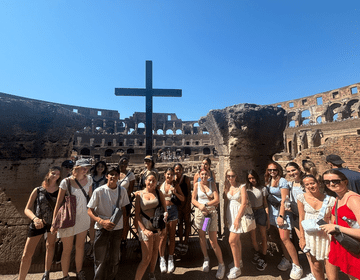Archaeological Exploration, Part 1: American Academy
After a relatively relaxing day yesterday, the students were once again ready to continue exploring more of Rome!
First, we began our day by visiting the American Academy in Rome, a research and arts institution founded in 1912 that provides scholarships and fellowships allowing Americans to study in Rome (the founders of this endowment include J. P. Morgan, John D. Rockefeller, and William K. Vanderbilt, among others). Students put on gloves and were able to handle a number of various artifacts, with one catch: they weren't told what they were! Our participants had to think about what they have learned so far in their art history classes and during their excursions over the past week, and deduce the purpose of many of the items based on the shape of the artifact, the material it was made from, and its resemblance to objects we still use today. Students learned that above all ancient Romans were cheap, and therefore very good at recycling materials, and gaudy : their statues and buildings were painted and decorated with many colors, unlike the stark white marble structures we are used to seeing. Being able to observe and think about these artifacts really made an impression on the students, and helped to expand their definition of what it means to be "exploring Rome through the arts": they learned that everyday tools and utensils can be beautiful, and artistic items can also have a practical use.
Some of the objects the students got to see up close were:
- Roman coins that included portraits of Augustus and the goddess Roma
- A dual nail and ear cleaner - similar to a modern-day Q-tip!
- A piece of pipe from Rome's elaborate aqueduct system, inscribed with the name of the owner
- Remnants of a statue
- A ritual bowl
- A stylus, used for writing and erasing on wax tablets
- A game piece
- A strigil - what athletes used to scrape themselves clean after workouts in the gymnasium
- An amphora, a vase-like container used for serving wine
- A loom weight and spool, found in a woman's grave
- An oil lamp
- Tweezers, which closely resembled the ones we still use today!
After traveling back in time by learning about these various artifacts, students were able to explore more of modern-day Rome by foot. First, we walked up to Gianicolo hill to get a birds-eye view of many of the famous monuments we have seen around the city so far. Then, we walked around the Trastevere neighborhood and visited the main piazza. The church in this piazza, the Basilica of Santa Maria in Trastevere, is one of the olders churches in Rome: the basic floor plan was created around 340 A.D., and much of the existing structure dates to around 1140. In the afternoon, our students had their final "Survival Italian" class in the area of Rome known as the Jewish Ghetto, which was established in 1555 by a Papal bull from Pope Paul IV that declared that all Jews in Rome must live in this area. This area has a rich history that spans centuries, and this lesson encouraged students to explore and learn about the neighborhood. They went on a scavenger hunt to look for some important monuments in the area, and were required to ask residents for directions in Italian, no Google Maps allowed! It was great to see the students becoming confident enough to navigate the city on their own!
Tomorrow, students will be continuing their archaeological exploration of Rome by visiting Ostia Antica, the site of an ancient harbor city. They will be using the same deductive reasoning they practiced today, but this time they will apply it to the buildings and architectural layout of the site. Stay tuned for tomorrow's post!
Related Posts
Lost in Florence: Finding Art in Every Corner
When Sam writes an article, you know the students are waking up early! Let's set aside thoughts of the Colosseum and the ancient Romans for a moment because we’re about... keep reading

Once Upon a time … in Tivoli!
Nestled in the Italian region of Lazio, the charming town of Tivoli is a testament to Italy's rich historical tapestry and natural beauty. Just a short drive from Rome, Tivoli has been a favored retreat since ancient times, offering a perfect blend of natural splendor and architectural marvels. Among its many attractions, Villa d’Este stands out as a jewel of Renaissance architecture and landscape design.

Rome-ing with CIEE: Colossal Adventures at the Colosseum and Forum!
The alarm rang a bit earlier today, signaling the start of an exciting day for the students and their Program Leaders as they embarked on their first bus ride in... keep reading










